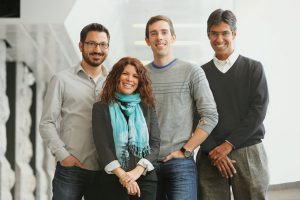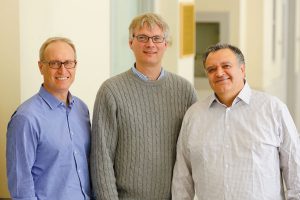The past decade has seen graduates of McGill’s Faculties of Science, Engineering and Medicine parlay their education into several thriving medical imaging start-up companies. Now a $1.6-million NSERC grant is bringing together today’s students with an industry hungry for the next generation of engineers and computer scientists. //
By Suzanne Bowness
If a picture is worth a thousand words, then the value of medical imaging — the ability to capture images of the human body for medical reasons — could be considered the MasterCard equivalent of picture-taking: priceless. Indeed, magnetic resonance imaging (MRI) procedures have become routine in and synonymous with clinical tasks that require an “inside” view of the body and its brain, muscles, connective tissues and, occasionally, tumours. In cognitive neuroscience and neurosurgery, for example, MR images are fuelling new understanding of how our brains work.
Kaleem Siddiqi, a professor at McGill’s School of Computer Science, and Tal Arbel, an associate professor in the Department of Electrical and Computer Engineering, specialize in shape analysis and probabilistic methods in computer vision and medical imaging. Their courses probe the frontiers of medical imaging: how does a computer interpret a medical image? What happens to image information when a three-dimensional scene is projected onto a two-dimensional picture?

Over the years, Siddiqi, Arbel and their colleagues in medical image analysis have watched fellow professors and recent graduates of the Faculties of Science, Engineering and Medicine take up employment in, or sometimes even found, successful medical imaging companies. Many of these companies, which bear inventive industry names such as NeuroRx, Biospective, Intelerad, Rogue Research and Resonant Medical (now part of Elekta), are based in Montreal, and as these companies have grown, they’ve looked to McGill to expand their highly skilled workforce. Students, in turn, have been eager for industry experience.
Seeing an opportunity to formalize this university-industry collaboration, Siddiqi, Arbel and their colleagues developed a proposal for a medical imaging analysis training program and submitted the proposal to the NSERC Collaborative Research and Training Experience (CREATE) grant competition. The CREATE awards seek to harness the talents of motivated science students by training them for the workplace, ideally in a field where their work will contribute to advancing the country’s research priorities. The McGill team’s proposal for a program in Medical Image Analysis — the CREATE-MIA program — was awarded a grant for $1.65 million over six years.
The project builds on a long history of collaboration, says Siddiqi. “The reason this team exists and the proposal was written was because people were already working together, so it made a lot of sense.”
The program highlights Quebec as a hub for innovative medical imaging research, with a decidedly local flavour to the co-applicants named in the proposal: seven researchers from three universities (McGill, Sherbrooke and École de technologie supérieure [ÉTS]), seven industrial partners from the Montreal area, and a handful of clinical and neurosurgical collaborators from universities across the province. Beyond their university affiliations, these researchers are also variously connected to other major local research centres, such as the Montreal Neurological Institute and Quebec’s Biomedical Imaging Network.

Bruce Pike, director of the McConnell Brain Imaging Centre (BIC) and one of three McGill professors of biomedical engineering, neurology and neurosurgery involved in the program, emphasizes the importance of building on these connections, which extend across the province. “We have seen the medical image analysis community in Quebec grow,” he says, “and this program represents an opportunity to keep that network cohesive, to continue the momentum of that large group of expertise, and to strengthen it.”
But while the researchers were already collaborating amongst themselves, typical supervisor-student silos meant that students didn’t see as much of the crossover. With the CREATE grant, whose very mandate lies in interdisciplinarity and collaboration, students will now be a part of this goal to work across faculties. In practical terms, this will mean taking part in professional development workshops and symposia with students from other departments, as well as taking courses that span an impressive range of fields, from computer science and electrical, computer and biomedical engineering, to neurology, neurosurgery and medical physics.
“The program provides a very rich, cross-collaborative and multidisciplinary environment where students become aware of and learn about larger parts of the project and different clinical applications of medical imagery,” notes Louis Collins, Pike’s colleague in biomedical engineering and at the BIC. “We will be collaborating with Maxime Descoteaux, who also does neurosurgery research, at Universit. de Sherbrooke, and with Catherine Laporte at ÉTS,” Collins continues. This means that students at these universities, as well as students at McGill, will have access to and benefi t from sharing data in the professors’ various areas of expertise, including image-guided surgery software, tracking software, and neurological and ultrasound data.
With generous funding that will allow between 20 and 25 students to go through the program every year for the next six years, the initiative is key to bringing high-quality students to the universities involved, Collins says. Amir Shmuel, assistant professor of biomedical engineering, agrees. “My hope is that this program will allow us to attract the best candidates and graduates in this field and increase the level of cooperation across disciplines,” says Shmuel. “I also hope that our graduates will be successful
leaders in academia or in the high-tech industry.”
Dante De Nigris Moreno, a PhD student who works with Tal Arbel in the Department of Electrical Engineering, welcomes the program’s emphasis on industry collaboration. “In academia, we do a lot of research and theory, but at the end, we want to provide a tool and software that is actually used in the operating room,” he says, “so it is natural to be on the same page as companies trying to solve the same problem.”
“As a PhD student, you often work on your own for four or five years and then get thrown into the workforce,” adds Emmanuel Piuze-Phaneuf, who works with Siddiqi and who says he jumped at the chance to participate in the program. “Here, you get to collaborate with companies in the medical sector and find out what they do and what they want. It was an opportunity I didn’t want to miss.”
Industry partnerships are rewarding for a variety of reasons, notes Arbel. “Students are excited to help provide tools that have health benefits to society, not just to make a lot of money but to have their research… help to develop drugs for particular diseases. Being of service to society is very exciting to them.”
Funding for the CREATE-MIA program is provided by the Natural Sciences and Engineering Research Council of Canada. To find out more about this program, visit www.cim.mcgill.ca/create-mia.
